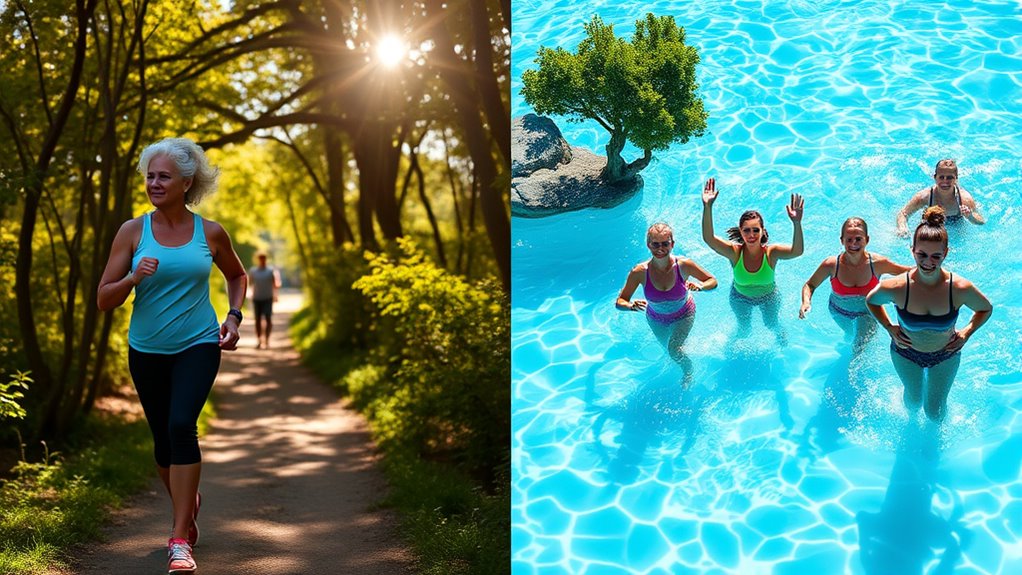If you have achy knees, water aerobics might be the better choice because it reduces joint impact with buoyancy, easing pain and encouraging movement. It also offers resistance to strengthen muscles around your knees without extra stress. Walking is low-cost and accessible but can strain your joints if done on hard surfaces or with improper form. To find out which activity suits you best and how to get started, keep exploring the details ahead.
Key Takeaways
- Water aerobics minimizes joint stress through buoyancy, making it ideal for those with knee pain.
- Walking provides gentle joint stimulation but may cause discomfort if performed on uneven surfaces or with improper form.
- Both activities promote joint health; water aerobics offers low-impact support, reducing risk of aggravating achy knees.
- Water exercises are especially suitable for individuals with existing joint issues, providing resistance without added strain.
- Walking can be beneficial if done with proper footwear and technique, but water aerobics generally offers a safer, gentler option for knee pain.
Understanding the Impact on Joint Health
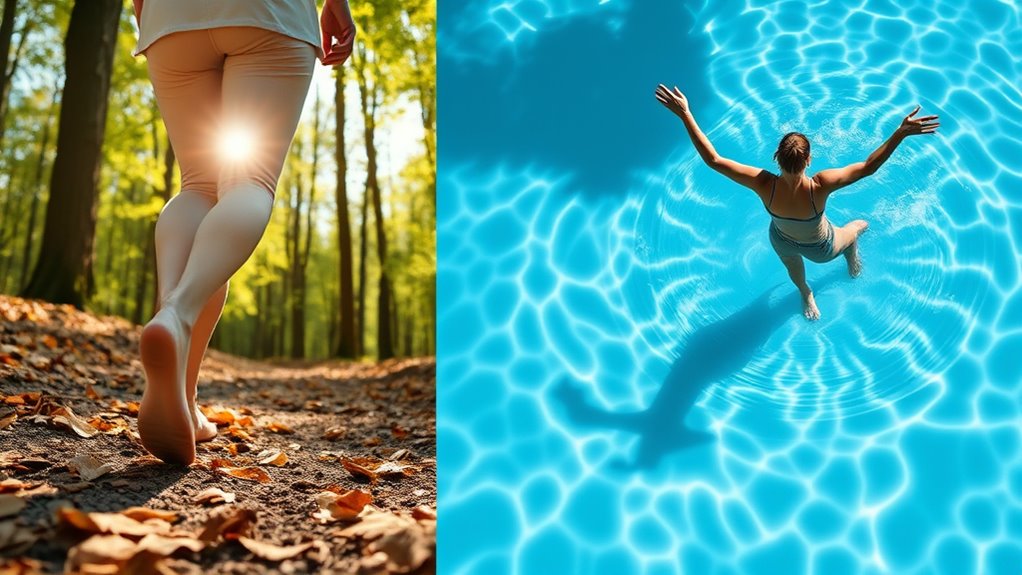
Walking and water aerobics both offer benefits for joint health, but they affect your joints differently. When you walk, your joints receive gentle stimulation that promotes joint lubrication, helping to keep your joints moving smoothly. This low-impact activity also aids in cartilage protection by encouraging healthy joint function without excessive stress. Water aerobics, on the other hand, provides resistance that strengthens muscles around your joints, offering additional support. The buoyancy reduces weight-bearing pressure, minimizing cartilage wear and tear. Both activities help maintain joint health, but water exercises are particularly gentle, making them ideal for those with existing joint issues or arthritis. Additionally, incorporating water resistance into your routine can enhance muscle strength without added strain. By choosing the right activity, you can support your joints effectively while staying active.
Comparing the Cardiovascular Benefits

Both walking and water aerobics boost your heart health, but they do so in different ways. Walking generally burns more calories per session, making it effective for calorie burn and weight management. It’s a steady, moderate activity that helps build stamina over time, especially with consistent effort. Water aerobics, on the other hand, offers a low-impact workout that still raises your heart rate, improving cardiovascular fitness without stressing your joints. While water exercises might burn fewer calories than walking, they’re excellent for endurance building in those with joint pain. Both forms support your cardiovascular health, but if stamina building and calorie burn are your goals, walking may have a slight edge. For those with joint issues, water aerobics provides a joint-friendly workout that still promotes cardiovascular health. Choose based on your comfort level and fitness needs.
Assessing the Risk of Injury and Strain
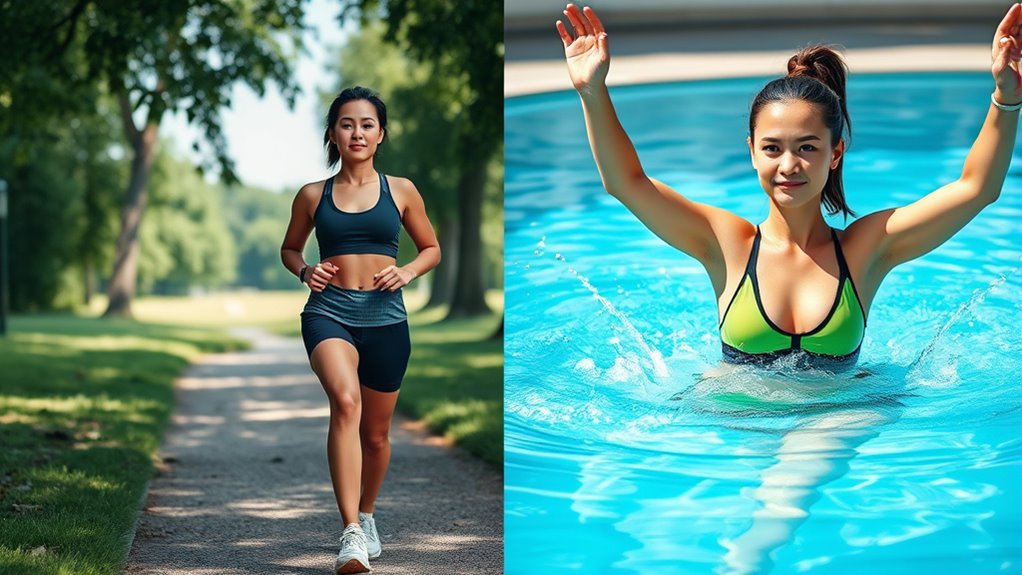
While engaging in physical activity can boost your health, it also carries the risk of injury or strain, which varies depending on the exercise type. Walking generally involves low-impact movements, reducing strain on your knees, but improper form or uneven surfaces can cause sprains or joint stress. Water aerobics offers support from water, lowering injury risk, yet slippery surfaces or overexertion can lead to slips or muscle strains. It’s important to think about medication interactions, as certain medications may affect balance or increase fall risk during either activity. Nutritional considerations are also crucial; adequate hydration and proper nutrition support tissue repair and reduce injury chances. Incorporating preventive measures like stretching and proper footwear can further decrease injury risk. Being mindful of these factors helps you safely enjoy the benefits of exercise while minimizing the risk of injury or strain.
Evaluating Accessibility and Convenience
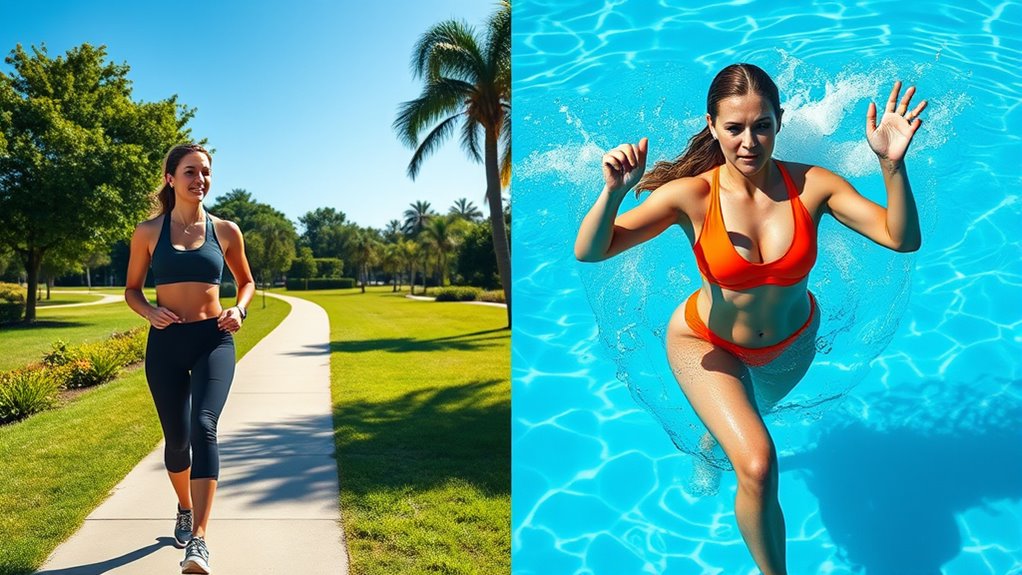
Considering the safety aspects of your exercise routine is important, and evaluating how accessible and convenient each option is can influence your consistency and enjoyment. Walking outdoors requires minimal equipment but depends on weather conditions, affecting temperature control and hydration needs. Water aerobics, usually in a pool, offers a controlled environment, reducing risks tied to extreme heat or cold. Accessibility varies: walking is available almost anywhere, while water aerobics may require a membership or nearby pool. Additionally, exercise environments play a role in how safe and suitable each activity is for individuals with specific health concerns.
Examining the Suitability for Different Fitness Levels

Whether you’re just starting your fitness journey or are an experienced athlete, choosing between walking and water aerobics depends on your current fitness level. If you’re a beginner, water aerobics offers gentle aquatic resistance that reduces impact on your knees while allowing you to build strength gradually. It’s easier to control your walking pace on land, but water provides added support, making it suitable for those with limited mobility. As your fitness improves, you can increase walking pace or incorporate more aquatic resistance to challenge yourself. Water aerobics can be adjusted for various levels, offering low-impact options that still promote cardiovascular health. Both activities can be tailored to meet your needs, making them versatile choices regardless of your fitness stage. Incorporating vocal techniques such as controlled breathing and proper posture can also help improve overall exercise performance and comfort.
Considering Recovery and Rest Periods
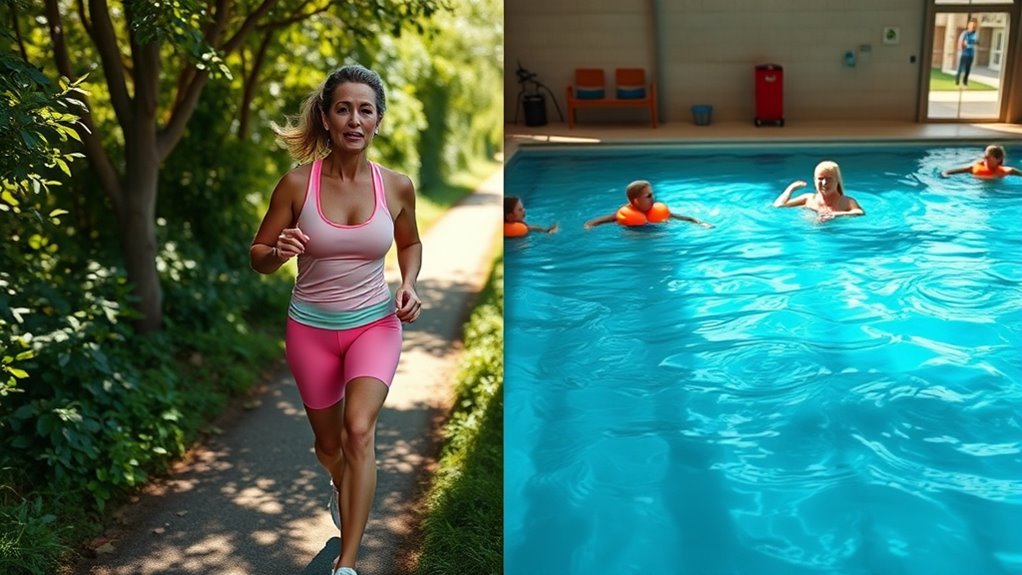
Recovery and rest periods are essential components of any fitness routine, and choosing between walking and water aerobics can influence how you incorporate these breaks. Your recovery strategies should consider the intensity and impact of each activity, as well as how your knees respond. Water aerobics offers low-impact exercise that allows for longer rest cycles without overexertion, helping to reduce inflammation and fatigue. Walking, especially at higher intensities or durations, requires more deliberate rest to prevent overuse injuries. The rest cycle importance lies in listening to your body, ensuring you don’t push through pain or fatigue. Proper rest helps your knees recover, reduces soreness, and improves overall performance, whether you’re walking or doing water aerobics. Incorporating tuning techniques can also optimize your activity levels and protect your knees from strain.
Cost and Equipment Requirements
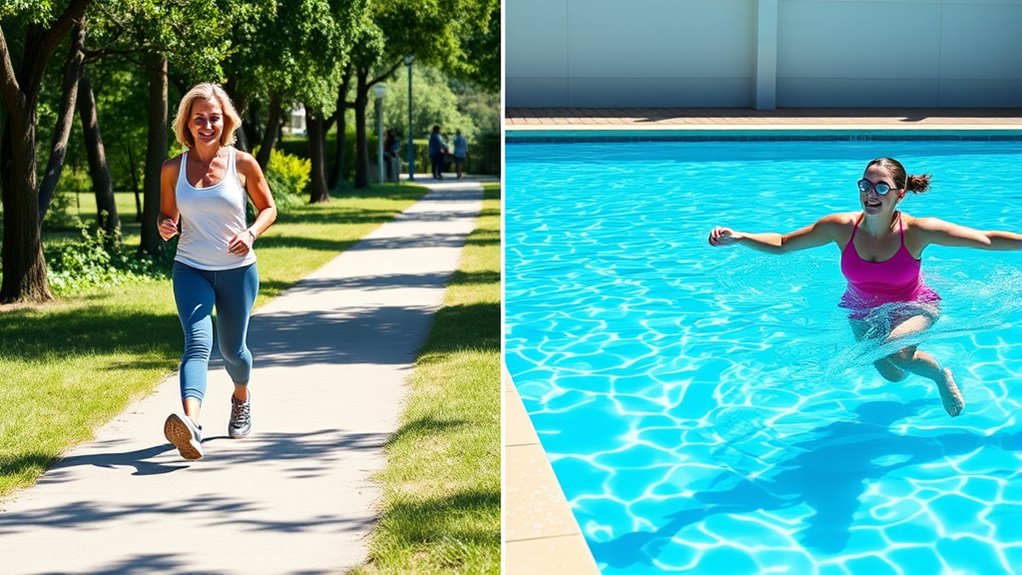
Water aerobics can cost more upfront due to class fees and specialized equipment, while walking mostly requires just a good pair of shoes. You’ll find that walking gear tends to be more affordable and easier to access, especially if you already own suitable shoes. Considering the expenses and equipment needs helps you decide which activity fits your budget and lifestyle better. Additionally, space optimization is important, as walking can be done almost anywhere, whereas water aerobics requires access to a pool or aquatic facility.
Water Aerobics Expenses
Getting started with water aerobics typically involves some upfront costs for equipment and class fees. You’ll want to invest in a good pair of water shoes to provide traction and protect your feet during workouts. These usually cost around $20 to $50, depending on quality. Additionally, you’ll need to pay pool fees, which vary by facility but generally range from $5 to $15 per session or a monthly membership fee. Some gyms include water aerobics classes in their membership, helping you save money in the long run. Keep in mind that extra equipment like waterproof headphones or resistance tools can add to your expenses if you choose to use them. Overall, water aerobics can be affordable, especially if you find a facility that offers bundled memberships or discounts. Incorporating a cozy farmhouse bedroom ambiance can make your home workout space more inviting and relaxing.
Walking Gear Costs
Starting with walking requires minimal equipment, making it a budget-friendly activity. You mainly need comfortable shoes suited for your gait. Good walking shoes provide water resistance, which can help protect your feet and improve stability. If you want to enhance your experience, consider these essentials:
- Supportive walking shoes with water resistance
- Moisture-wicking socks to prevent blisters
- A hat or visor for sun protection
- Reflective gear for safety during low light
Using proper footwear can also help reduce joint stress and support your knees during activity. Unlike aquatic therapy, which involves specialized gear, walking gear costs are generally low. Investing in quality shoes can reduce knee strain and support your joints. Overall, walking gear is affordable and straightforward, making walking an accessible option for knee comfort.
Equipment Accessibility
Compared to water aerobics, walking equipment is generally more accessible and affordable. You only need a good pair of walking shoes to get started, which are widely available and inexpensive. In contrast, aquatic gear like swimsuits, goggles, and snorkels can add up, especially if you participate regularly. Walking shoes provide necessary support and cushioning, reducing knee strain, while aquatic gear ensures comfort and safety in the water. Water aerobics also require access to a pool, which may involve membership fees or limited hours, making it less convenient and cost-effective for some. With walking, you can exercise almost anywhere, anytime, with minimal equipment. Additionally, walking allows for customizable intensity, enabling you to tailor your workout to your comfort level and knee condition. Overall, walking’s equipment requirements and costs make it a more approachable option if budget and convenience matter most.
Personal Preferences and Lifestyle Compatibility

Choosing between walking and water aerobics often depends on your personal preferences and lifestyle. If you enjoy exercising outdoors, walking offers fresh air and natural scenery that can boost your mood. Water aerobics, on the other hand, suits those who prefer a controlled environment, especially if you enjoy social interaction in a class setting. Consider these factors:
Choose walking for outdoor freshness or water aerobics for social, indoor fun.
- Do you prefer outdoor activities or indoor workouts?
- Are you motivated by social interactions with others?
- Do you want a flexible schedule or set class times?
- Is your goal to combine exercise with enjoying nature or building community?
Additionally, incorporating low-impact exercises like water aerobics can be especially beneficial for individuals with knee issues, helping to reduce joint stress while staying active. Your choice should align with what keeps you consistent and engaged, making it easier to stick with your routine and protect your knees.
Frequently Asked Questions
Which Exercise Burns More Calories per Session?
Water aerobics generally burns more calories per session than walking, thanks to its higher session intensity. When you engage in water exercises, you use more muscle groups and resist water, increasing calorie burn. While walking is easier on your knees, water aerobics offers a more vigorous workout, leading to a greater calorie comparison per session. So, if your goal is maximum calorie burn, water aerobics might be the better choice.
Can Water Aerobics Help Improve Joint Flexibility?
Yes, water aerobics can help improve your joint flexibility. The water’s natural resistance allows you to perform gentle joint stretching, which enhances mobility without putting too much stress on your knees. Moving through the water helps loosen tight joints, making it easier to maintain or increase flexibility over time. Plus, the buoyancy reduces impact, so you can work on joint health comfortably and safely.
How Do Weather Conditions Affect Outdoor Walking Routines?
Weather conditions profoundly impact your outdoor walking routines. You might hesitate during extreme weather patterns or temperature fluctuations, but staying flexible helps. Cold, hot, or rainy days can make walking uncomfortable or unsafe, so check the forecast first. Dress appropriately, choose shaded paths, or consider indoor alternatives when weather is unfavorable. Adapting to weather patterns ensures you stay active without risking discomfort or injury.
Are There Specific Water Exercises for Severe Knee Pain?
Yes, you can try aquatic stretching and knee strengthening exercises designed for severe knee pain. Gentle aquatic stretching helps improve flexibility without straining your joints, while knee strengthening in water builds muscle support around your knees safely. Focus on slow, controlled movements, and always listen to your body. Consulting a physical therapist can help tailor exercises that suit your specific needs and help ease your severe knee pain effectively.
How Does Each Activity Impact Long-Term Joint Health?
Walking and water aerobics both support long-term joint health, but water exercises often better preserve cartilage and reduce impact stress, aiding in joint preservation. Walking encourages weight-bearing activity that can strengthen muscles around your knees, but if done excessively or improperly, it may accelerate cartilage wear. Water aerobics minimizes joint strain, helping maintain cartilage health over time. Combining both, tailored to your needs, can optimize joint preservation and long-term knee health.
Conclusion
Ultimately, whether walking or water aerobics wins for your achy knees depends on what suits your body and lifestyle best. Both options pack a punch when it comes to easing joint pain and boosting fitness—like having a secret weapon in your health arsenal. Listen to your body, consider your preferences, and choose the one that keeps you moving happily. After all, staying active is your golden ticket to a healthier, happier you—no matter which path you take!
